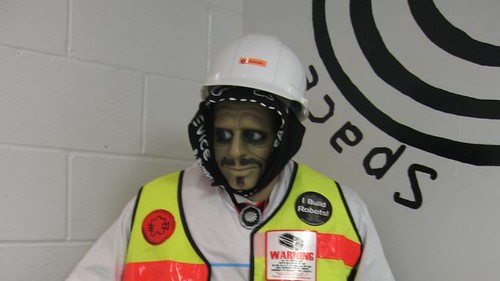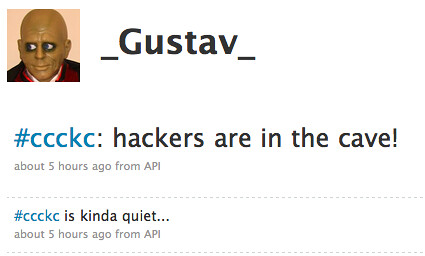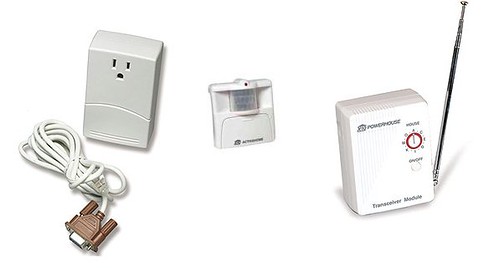
Early on in Cowtown Computer Congress' progress, Gustav became our official mascot. When Jestin bought Gustav at a garage-sale, he was a "butler" statue that held a tray. This was probably for halloween candy. Gustav's primitive electronics could sense people nearby with a photocell and do simple actions like breathe and move his eyes. Mostly, though, he just looked kind of cool. We formally adopted Gustav as Professor Emeritus of our hackerspace.
Over the last year or so, we've changed his clothes, added accessories, "facial hair", a remote speaker with a voice changer and swapped out all his circuitry with some homebrew stuff. Usually, Gustav just sits there with a smirk on his face, watching over the hackerspace. Sometimes, he finds his way over to the door and startles people when they first enter the space too. Such an ornery guy.
As CCCKC's official mascot, he has a twitter account. That's in addition to the CCCKC twitter account that's used more for CCCKC-related news.
Since Gustav watches over our hackerspace, I thought it appropriate to empower him to let others know when people are hanging out with him. This is done with a motion sensor. The first time Gustav sees activity, he will tweet about it. As long as people keep moving around, he observes stoically. When the hackerspace remains idle (currently, I'm using 30 minutes as the time-out), he tweets again to notify others that things have gone quiet. I didn't want to clutter the CCCKC twitter feed with such minutiae as the comings-and-goings of hackers on a daily basis, so Gustav chronicles their activity dutifully in his own feed.

This solves the problem of passively letting others know when there's something going on, but keeps privacy at a maximum. Without calling or visiting, there's no way to tell who is doing what at CCCKC, just that there's something going on. This solution avoids the problems posed by public-access webcams and other solutions that might give away too much information for some peoples' comfort.
Hardware
- An old 1U Rackmount x86 system I had laying around
- X10 TM751 Transceiver
- X10 CM11A Bi-Directional Serial Interface
- X10 MS13A "Hawkeye" motion sensor

The Hawkeye motion sensors are pretty weak. I eventually want to buy six more ($60 total at the evil website that sells them) so that full coverage can be had for all the rooms at CCCKC. They simply send an RF signal to the X10 Transceiver.
The signal is then placed on the electrical system for any peripherals to detect. In this case, the only peripheral for now is the CM11A serial interface. I could have the motion detector turn lights on and off, sound a chime, or perform several other actions if I wanted. For now, I'm interested in getting the motion detector input to the computer.
The CM11A can sense X10 network data on the electrical system, and can also send X10 network data as well.
Software
OpenBSD is a spartan operating system that works well on slow systems. It has a minimal installation footprint but maintains a rich developer environment for compiling software. It was chosen because it was already installed on the 1U system I am using for the project, and because I've already used Heyu on OpenBSD in the past without any problems.
Curl is a command line tool for transferring files with URL syntax. It's lightweight and works well. Its only job will be to update Twitter from within a shell script.
Heyu is a software package with the ability to make sense of the X10 data and act on it. It's quite extensible, but I'm only using it to trigger a shell script.
Configuration
Compiling and installing heyu on OpenBSD is straight-forward. Unpack the tarball, run "make" and then as root, run "make install"
This is the heyu configuration file I put together. There isn't a default configuration file installed, so heyu isn't "install and go" by any means. This file is /etc/heyu/x10config
TTY /dev/tty00The HEYUHELPER Script Mode just tells heyu to look for a script in the path called "heyuhelper" and run it. It passes some X10 parameters in the arguments, but for the time being, I am not using them. The above configuration is almost the simplest one you can put together and have a working Heyu install.
HOUSECODE C
SCRIPT_MODE HEYUHELPER
To make heyu start automatically at boot, I placed the following in /etc/rc.local:
/usr/local/bin/heyu -c /etc/heyu/x10config start
The "heyuhelper" script mentioned above, is just a quick line of shell in /usr/local/bin/heyuhelper that appends an epoch timestamp to a log file. This can be extended quite a bit to address individual sensors for determining which rooms are in use. For now, I'm keeping it simple. As configured, any X10 trigger on the house-code Heyu is monitoring will append a timestamp to the log file.
#!/bin/sh
date +%s >> /var/log/motion.logThe final piece of the puzzle is a script: /usr/local/bin/cavecheck.sh, that runs from cron.
#!/bin/sh
curdtme=`date +%s`
lastdtme=`tail -1 /var/log/motion.log`
dif=`expr $curdtme - $lastdtme`
if [ "$dif" -lt 1800 ]
then
if [ ! -e "/var/log/caveactive" ]
then
/usr/local/bin/curl --basic --user "username:somepass" \
-d status="#ccckc: Hackers are in the cave!" \
http://twitter.com/statuses/update.xml
touch /var/log/caveactive
fi
fi
if [ "$dif" -gt 1800 ]
then
if [ -e "/var/log/caveactive" ]
then
/usr/local/bin/curl --basic --user "username:somepass" \
-d status="#ccckc is kinda quiet..." \
http://twitter.com/statuses/update.xml
rm /var/log/caveactive
fi
fi
The cron entry itself is pretty easy. I added this to /var/cron/tabs/root so that it runs once every minute.* * * * * /usr/local/bin/cavecheck.shOnce configured, I rebooted the system to make sure that everything came up automatically the way it should. If you're not down for that, simply sending a HUP signal to cron and starting heyu manually should work fine.
Once I get more motion sensors and all of the rooms are being monitored, I'll probably turn the timeout down to 15 minutes or less.




